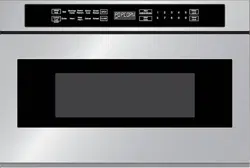Loading ...
Loading ...
Loading ...

EN
3
About Unpacking and Examining Your
Drawer Microwave
1. Remove all packing materials from inside the Drawer
Microwave. DO NOT REMOVE THE WAVEGUIDE
COVER, which is located on the ceiling of the microwave
cavity.
2. Check the drawer for any damage, such as misaligned
or bent drawer, damaged drawer seals and sealing
surfaces, broken or loose drawer guides and dents inside
the cavity or on the front side of the drawer. If there is any
damage, do not operate the microwave and contact your
dealer or a FULGOR MILANO AUTHORIZED SERVICER.
Waveguide
Cover
Sealing
Surface
Oven
Cavity
Sealing
Surface
Radio or TV Interference
Should there be any interference caused by the appliance
to your radio or TV, check that the Drawer Microwave is
on a different electrical circuit, relocate the radio or TV as
far away from the drawer as feasible or check position and
signal of receiving antenna.
GROUNDING INSTRUCTIONS
This appliance must be grounded. The Drawer Microwave
is equipped with a cord having a grounding wire with a
grounding plug. It must be plugged into a wall receptacle
that is properly installed and grounded in accordance
with the National Electrical Code and local codes and
ordinances. In the event of an electrical short circuit,
grounding reduces risk of electric shock by providing an
escape wire for the electrical current.
WARNING - Improper use of the grounding plug can result
in a risk of electric shock. Do not use an extension cord. If the
power supply cord is too short, have a qualified electrician
or serviceperson install an outlet near the appliance.
If you have any questions about the grounding or electrical
instructions, consult a qualified electrician or serviceperson.
About Your Drawer Microwave
ALWAYS have food in the appliance when it is running to
absorb the microwave energy.
The vent under the Drawer Microwave must not be blocked.
During microwaving, steam may come from the left side
lower vent (when facing the product).
When using the microwave at power levels below 100%,
you may hear the magnetron cycling on and off. It is normal
for the exterior of the drawer to be warm to the touch when
cooking or reheating.
Condensation is a normal part of microwave cooking and
the amount being vented is directly related to the moisture
content of the food and room humidity. A cooler room will
produce more condensation. Attention should be paid to
the vented area after each use of the product and wiped
down if needed.
The Drawer Microwave is for food preparation only. It
should not be used to dry clothes or newspapers.
In using recipes or package directions, check food a minute
or two before the minimum time and add time accordingly.
When opening or closing the drawer quickly, food in the
appliance may be spilled. To clean, please refer to the
Cleaning and Care section on page 17.
A good microwave cookbook is a valuable asset. Check it for
microwave cooking principles, techniques, hints and recipes.
About Microwave Cooking
• Arrange food carefully. Place thickest areas towards
outside of dish.
• Watch cooking time. Cook for the shortest amount of
time indicated and add more as needed. Food severely
overcooked can smoke or ignite.
• Cover foods while cooking. Check recipe or cookbook
for suggestions: paper towels, wax paper, microwave
plastic wrap or a lid. Covers prevent spattering and help
foods to cook evenly.
• Stir foods from outside to center of dish once or twice
during cooking, if possible.
• Turn foods over once during microwaving to speed
cooking of such foods as chicken and hamburgers. Large
items like roasts must be turned over at least once.
• Rearrange foods such as meatballs halfway through
cooking both from top to bottom and from right to left.
• Add standing time. Remove food from the microwave and
stir, if possible. Cover for standing time which allows the
food to finish cooking without overcooking.
• Check for doneness. Look for signs indicating that
cooking temperatures have been reached.
Doneness signs include:
- Food steams throughout, not just at edge.
2 - INFORMATION YOU NEED TO KNOW
Loading ...
Loading ...
Loading ...
